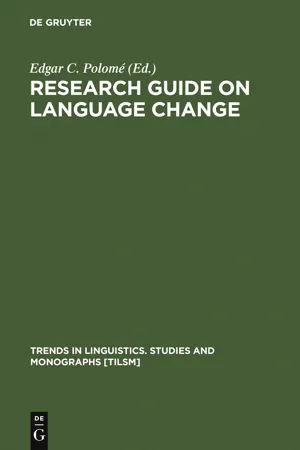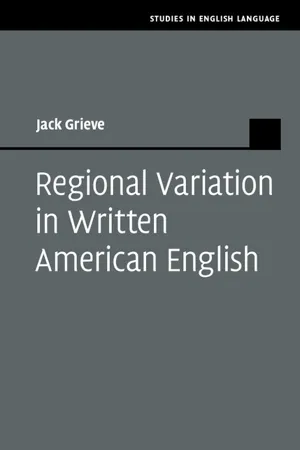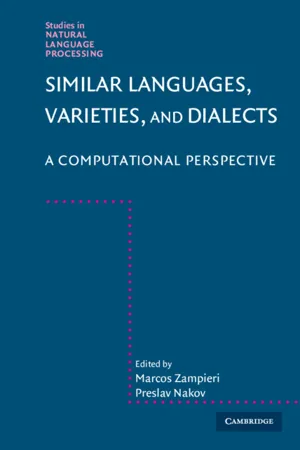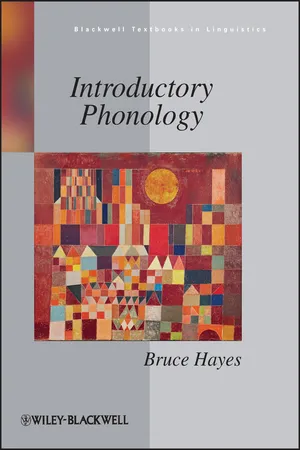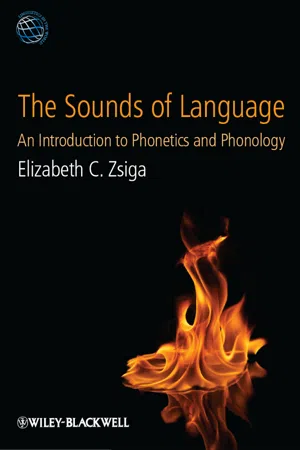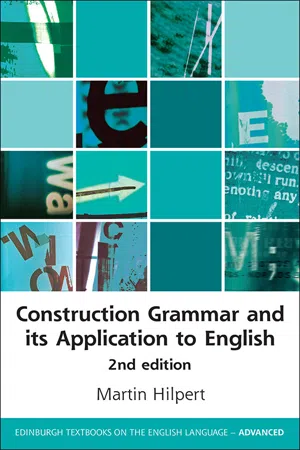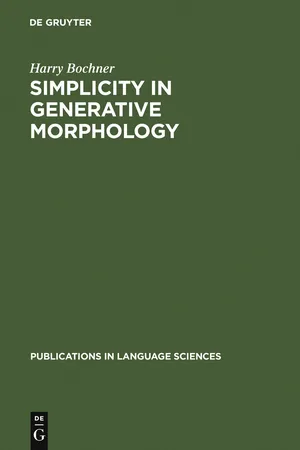Languages & Linguistics
Alternation
Alternation refers to the variation or change in linguistic elements, such as sounds, words, or grammatical structures, within a language. It can occur due to different phonological, morphological, or syntactic processes and often reflects the diverse ways in which a language expresses meaning. Understanding alternation is crucial for analyzing language patterns and identifying linguistic rules and regularities.
Written by Perlego with AI-assistance
Related key terms
1 of 5
8 Key excerpts on "Alternation"
- eBook - PDF
- Edgar C. Polomé(Author)
- 2011(Publication Date)
- De Gruyter Mouton(Publisher)
In both cases, Alternation is the key notion * We would like to thank Linda R. Waugh for some useful comments. 326 Frans van Coetsem and Susan McCormick in morphophonology and serves as the basis for further distinctions, such as the status of an Alternation with morphological function as either the primary (relevant) or concomitant (redundant) marker of the morphological distinction in question. The differing viewpoints on how morphophonology should be de-fined has also led to disagreement among linguists as to which types of Alternations are to be included within the morphophonological domain and which belong to phonology and morphology proper. In spite of the divergent opinions concerning the validity and definition of a separate morphophonological section in linguistic description, the occurrence of Alternations that operate within morphemes is a linguistic fact that should be described and accounted for. In the next few pages, we will isolate some representative examples of Alternations, and look at the various major approaches to synchronic morphophonological analysis. We will then discuss the diachronic perspective of morphophonology, in particular how the synchronic Alternation types relate to specific diachronic developments. For a survey (with bibliography) of the general and representative views on morphophonology, see Kilbury (1976) and Dressier (1985: especially 1 — 8). 2. Alternation An Alternation is composed of alternants and can be schematized as an operation of the type: A ~ Β C...) The Alternation occurs within morphemes. When speaking of mor-phemes in this context, especially pertinent are the notions of code frequency (either an open or a closed list) and message frequency. - Jack Grieve(Author)
- 2016(Publication Date)
- Cambridge University Press(Publisher)
chapter 3 Grammatical analysis To identify patterns of regional grammatical variation in the corpus of American letters to the editor, 135 grammatical Alternation variables were measured and mapped across the 240 city sub-corpora. All these Alternation variables are grammatical, in the general sense of the term, because they are based on variation in how words, sentences, and texts are constructed, including Alternations involving contraction, morphology, function words, word deletion, word order, and word classes. This chapter introduces these 135 grammatical Alternation variables and provides maps plotting each of their 295 variants across the United States, which represent the first and basic results of this study. Before presenting these grammatical Alternations, the general concept of an Alternation variable is defined, and the approach taken to selecting, measuring, and mapping these Alternations is described. 3.1 Alternation variables An Alternation variable is commonly described as a set of two or more ways of saying the same thing. More formally, an Alternation variable is defined as a set of distinct linguistic forms that have the same referen- tial meaning (Labov, 1966b, 1972; Wolfram, 1991; Geeraerts, Grondelaers, & Bakeema, 1994; Chambers & Trudgill, 1998; Speelman, Grondelaers & Geeraerts, 2003; Tagliamonte, 2006). Each of these equivalent linguis- tic forms is known as a variant of the Alternation variable. Because these variants – which can be speech sounds, morphemes, words, or grammatical constructions – have the same basic meaning, they can be used interchange- ably in discourse, at least in certain contexts, without changing the referen- tial information that is being expressed. For example, the pronunciation or deletion of post-vocalic /r/ constitutes a phonological Alternation variable, where each realization of the post-vocalic /r/ corresponds to a variant of that Alternation.- eBook - PDF
Similar Languages, Varieties, and Dialects
A Computational Perspective
- Marcos Zampieri, Preslav Nakov(Authors)
- 2021(Publication Date)
- Cambridge University Press(Publisher)
Part I Fundamentals 1 Language Variation James A. Walker 1.1 Introduction: Defining Language Variation Language variation can be defined as “different ways of saying the same thing,” where “different ways” refers to differences in the form of language (sounds, words, sentences, ways of speaking) and “the same thing” refers to the intended meaning conveyed by those forms: talking about things or events in the world, marking distinctions required by the language’s grammar, conveying the speaker’s intention, or indicating something about the speaker’s social position or relationship to the listener. Let us start by distinguishing variation between languages (interlinguistic variation) from variation within languages (intralinguistic variation). 1.1.1 Interlinguistic Variation Different languages say the same thing in different ways. The words j¯ ι (Chinese), frango (Portuguese), and kuku (Swahili) are different sequences of sounds that all refer to the same animal as the English word chicken. Since the relationship between form and meaning differs arbitrarily from language to language, and there is no way to figure out the meaning of a word based only on its sounds, learning a language involves making the connection between forms and the meanings conveyed by those forms. Interlinguistic variation goes beyond the words that each language uses to refer to things. The human vocal apparatus is capable of producing many different sounds, but each language uses only a subset of these sounds for the purposes of speech and uses them in ways that differ from the way that other languages use them (phonology). The English sounds represented by the spelling th (as in thin or the) are not used in other languages, while sounds such as German ch (as in Bach) or the “click” sounds in languages such as Xhosa are not used in English. These differences make it difficult for some learners of English to pronounce th or for speakers of English to pronounce German ch or Xhosa clicks. - eBook - ePub
- Bruce Hayes, Bruce P. Hayes(Authors)
- 2011(Publication Date)
- Wiley-Blackwell(Publisher)
6 Phonological Alternation I6.1 Alternation as a Consequence of Phonology–Morphology Interaction
A morpheme is said to alternate when it appears in different forms in different contexts. The analysis of Alternations is one of the central areas of phonology.Alternation often arises because of the way that phonology interacts with morphology. To show how this happens, it will be useful first to present some background material on the morphology and phonology of English.6.1.1 Alternations in English /t/-final stems
Here are some phonological rules of English, some repeated from earlier, all of which apply to the phoneme /t/ and give rise to Alternation. The rule of Preglottalization derives the preglottalized allophones of /p, t, k/ when they occur in word-final position:PreglottalizationA voiceless stop is realized as preglottalized when in final position.By “preglottalized,” I mean that the vocal cords slam shut just before the stop is made. This is represented in the feature system with the feature [+constricted glottis], and transcribed here with a preceding superscript glottal stop. Here are representative data:Preglottalization is optional, but we will ignore this fact here, with no harm to the point being made.cap /kæp/ [kæˀp] hat /hæt/ [hæˀt] hack /hæk/ [hæˀk] The rule of Tapping (p. 32) realizes the /t/ phoneme as a tap [ɾ] just in case it occurs between two syllabic sounds of which the second is stressless. Using the features of chapter 4, it appears as follows:Tapping1Tapping is also optional, at least for some speakers. English also has an allophonic rule of Aspiration, which applies obligatorily to the voiceless stops /p, t, tʃ, k/, rendering them [+spread glottis]. A rough statement of the rule is given below. - eBook - PDF
- Joseph Gafaranga(Author)
- 2007(Publication Date)
- Palgrave Macmillan(Publisher)
(2003: 135) 178 Talk in Two Languages That is to say, in Applied Linguistics, there is a preference for research to aim to influence actual practices on the ground rather than 'grand' policies. As we have seen above, a long tradition in Applied Linguistics has been to use linguistic analyses to contribute to educational issues. Following in this tradition, applied studies of language Alternation have mainly focused on classroom contexts (see Martin-Jones, 1995, 2000 for an over- view). According to Ferguson (2004), this body of research identified three main categories of functions that language Alternation serves in the classroom, namely (i) curriculum access, (ii) classroom management and (iii) management of interpersonal relations in the classroom. In identifying these functions, classroom research used existing models of language Alternation. For example, issues of class management drew on the idea that language Alternation is a contextualisation cue (Gumperz, 1982; Auer, 1984). Likewise, the idea that language Alternation in the classroom serves in the management of interpersonal relations was facilitated by the models of language Alternation I have referred to as identity-related explanations. Finally, it was possible to appreciate the role of language Alternation in curriculum access thanks to notions such as competence-related language preference (Auer, 1984, 1995; Torras and Gafaranga, 2002). Because language Alternation in the classroom was found to be func- tional, researchers drew implications about 'how to act differently'. Since, as Roberts (2003: 135) says, qualitative 'researchers are more likely to have an impact by trying to change practice rather than through grand attempts at engineering policy change', researchers' recommend- ations were first and foremost addressed to teachers. - eBook - PDF
The Sounds of Language
An Introduction to Phonetics and Phonology
- Elizabeth C. Zsiga(Author)
- 2012(Publication Date)
- Wiley-Blackwell(Publisher)
Phonology studies the social and mating habits of speech sounds. Paul Smolensky and Geraldine Legendre, The Harmonic Mind, 2006, p. 26 11 Phonotactics and Alternations Chapter outline 11.1 Phonotactic constraints 222 11.1.1 Actual words and possible words 222 11.1.2 Absolute and statistical generalizations 223 11.1.3 Borrowings 224 11.2 Analyzing Alternations 225 11.3 Alternations: what to expect 232 11.3.1 Local assimilation 232 11.3.2 Long-distance assimilation 236 11.3.3 Coalescence 238 11.3.4 Dissimilation 238 11.3.5 Lenition and fortition 240 11.3.6 Epenthesis 241 11.3.7 Deletion 243 11.3.8 Lengthening and shortening 244 11.3.9 Metathesis 244 11.3.10 Morphological interactions 245 The Sounds of Language: An Introduction to Phonetics and Phonology, First Edition. Elizabeth C. Zsiga. © 2013 Elizabeth C. Zsiga. Published 2013 by Blackwell Publishing Ltd. 222 PHONOTACTICS AND AlternationS In this chapter, we begin to investigate the question, “What does it mean to know a language?” focusing on the evidence from phonotactics (possible sound sequences) and Alternations (positionally-conditioned changes). As Smolensky and Legendre put it in the epigraph, phonotactics might be considered the social habits of speech sounds: what sounds go together, and where can they be found? Alternations might be considered mating habits: when sounds get together they interact, things happen, and new sequences come into being. We begin in Section 11.1 with a discussion of phonotactic constraints: how does a speaker know whether a word is possible in her language or not? What form does the knowledge take? How are phonotactic constraints evidenced in borrowings? The bulk of the chapter, however, is devoted to Alternations: what happens to sequences of sounds when phonotactic constraints are violated? Section 11.2 discusses general procedures for diagnosing and describing alter- nations in a phonological analysis. - Martin Hilpert(Author)
- 2019(Publication Date)
- EUP(Publisher)
Section 8.4 discusses the role of language change in Construction Grammar. The section will spell out how historical language change relates to the main topics of the previous sections, namely intra-speaker and inter-speaker variability. Section 8.5 focuses on Diachronic Construction Grammar LANGUAGE VARIATION AND CHANGE 181 and raises three questions that are currently under debate. Section 8.6 concludes the chapter. 8.2 Constructional variation 8.2.1 There’s more than one way to do it What does it mean to say that there is variation in a construction? In the simplest of terms, it means that there is always more than one way to use a construction. For instance, speakers of English have different ways of pronouncing a lexical construction such as secretary . Depending on their speech rate at the time of pronouncing the word, the result might consist of four syllables, as in / s ε .kr .t ə .r /, or it might have only three syllables, as in / s ε .kr .tr /. Besides variation in the quantity or length of how a word is realised, there is of course also qualitative variation, so that the same phonological segments are produced, albeit in qualitatively different ways. To illustrate, the same speaker might say / s ε .kr .t ə .r / on some occasions but / s ε .kr .t ə .ri/, with a higher final /i/, on other occasions. Different ways of pronouncing the same word reflect variation at the formal pole of a lexical construction. Recall that a construction is defined as a generalisation that speakers make: a certain form corresponds to a certain meaning. Taken together, these two poles form a symbolic unit. What constructional variation shows is that generalisations of this kind are not quite as simplistic as a one-to-one mapping of a single, invariant form to a single, invariant meaning.- eBook - PDF
- Harry Bochner(Author)
- 2011(Publication Date)
- De Gruyter Mouton(Publisher)
172 Alternations in phonological form 5 . 1 . Morphological and phonological Alternations This section surveys the boundary between morphology and phonology in two ways. First, I give a series of examples representing the range of phenomena in question. Each example involves affixation plus an Alternation, i.e., some change in the shape of the stem. Some Alternations are recognized as phonological by all theories; others fall into the grey area where theories differ on the classification of the phenomenon. Second, I discuss the main theoretical approaches that have been taken to this range of phenomena, attempting to classify these approaches into types, and introducing the LRM position. Let us start the survey of the phenomena by looking at a case of affixation accompanied by an Alternation that is generally agreed to be purely phonological in nature, and then progressing to cases that are more morphological in nature. (1) [wok] - [ wokiq] (walk - walking) The morphological relationship here involves simply the affixation of /iq/. What interests us here is the additional phonetic distinction between the two surface forms. The [ic] of walking, in the environment of a front vowel, is slightly less back than the [k] of walk. The two phones [k] and [R] never contrast in English, and the choice between them is determined entirely by the phonetic environment, i.e., by the neighboring vowels. This kind of Alternation is accepted as phonologi-cal by all theories. (2) Russian [rot] - [roda] ('family', nom. sg. - gen. sg.) This example, like the previous one, involves affixation, and an accompanying change in the phonological shape of the stem. Voiced obstruents never occur finally in Russian; whenever a stem like rod-occurs without a suffix, we find the voiceless counterpart of the stem-final obstruent. Thus the Alternation between [d] and [t] here is automatic, just like the Alternation between fk] and [k] above.
Index pages curate the most relevant extracts from our library of academic textbooks. They’ve been created using an in-house natural language model (NLM), each adding context and meaning to key research topics.
